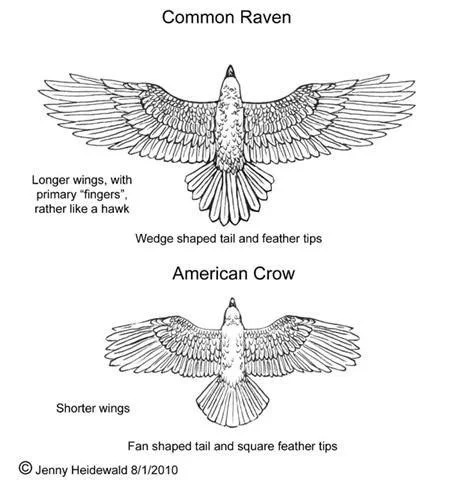Author: J.K. Ullrich
A murder of crows. A conspiracy of ravens. How did these shadow-winged birds swoop into our imaginations as bad omens? Both belong to the Corvid family, known for their problem-solving ability and complex social interactions. Their cleverness and sound mimicry may have seemed uncanny to early observers. Scavenging carrion for food also associated them with death. Whatever the initial inspiration, superstition about crows and ravens goes back millennia.
In Celtic folklore, a war goddess called the Morrígan appears on battlefields as a crow or raven to foretell the warriors’ fate. Norse myth also casts ravens in a supernatural role: a pair of birds named “Thought” and “Memory” fly around the world to collect knowledge for the chief god, Odin. Ancient influences evolved into a Gothic literature motif. Nineteenth-century author Edgar Allan Poe made the bird a messenger of grief in his poem The Raven, with the corvid croaking the famous catchphrase “nevermore”.
Today, Halloween decorations often feature spooky black birds. But are they crows or ravens? Among the birds of Alaska, they are most likely Common Ravens (Corvus corax) or American Crows (Corvus brachyrhynchos), although some ornithologists argue that crows found in the Pacific Northwest are a distinct subspecies from those in the Lower 48. These species may look similar at a glance, but it doesn't take a seer to distinguish them, just keen eyes and ears. Three clues to telling a raven from a crow are movement, vocalization, and appearance.
Movement
Like hungry trick-or-treaters swarming through a neighborhood, crows move in large flocks. Young ravens will sometimes group together, too, but adults usually travel alone or in pairs. Crows have a straightforward flight style with smooth flapping motions. Ravens are acrobats. A dark bird that rolls and dives in the air, or circles on the thermals like a raptor, is probably a raven.
Examine the silhouette as the bird soars overhead. Raven tails have a wedge shape, and primary feathers point out from their wingtips like witch's fingers. A crow's wings and tail are blunter.
Note the differences in size and tail feathers between Crows and Ravens. Sourced from: https://www.wildawareutah.org/wildlife/crows-ravens/]
Vocalization
Both species use a range of sounds to communicate with others. The crows’ repertoire includes clicks, rattles, and the classic caw caw believed to be a territorial call. A raven’s deeper croak carries for more than a mile. Short shrieks chase off interlopers. A rasping cry indicates a disturbance near their nest. Dominant females may make a series of knocking sounds. Ravens can mimic other birds, and even learn words when raised in captivity. Scientists have identified more than 30 different raven vocalizations. Listen to crow and raven calls in this video from the Cornell Lab of Ornithology.
Appearance
Both corvid cousins dress in black, but it's far from a funeral outfit. Their plumage shimmers with iridescent purples and greens. A raven's feathers often have more sheen than a crow's. Despite the birds' similar coloration, there's a significant difference in size. Ravens are much larger, comparable to Red-tailed Hawks. Crows are roughly the size of pigeons (a species that gives some city-dwellers more nightmares than any Corvid). The average raven weighs twice as much as a crow, tipping the scale at more than two pounds!
Up close, the birds have subtly different facial features. Crows' necks are smooth, while ravens boast a luxuriant ruff of feathers (not unlike a cravat Mr. Poe might have worn). Still unsure of the identification? The nose knows: ravens' beaks are larger and more curved than crows, with longer bristles at the base.
Left: American Crow in Whitter. Photo credit: Ianaré Sévi, CC BY-SA 3.0 <https://creativecommons.org/licenses/by-sa/3.0>, via Wikimedia Commons
Right: Common Raven, Alaska. Photo credit: USFWSAlaska, Public domain, via Wikimedia Commons
Are Corvids Really Creepy?
If you still think corvids are creepy, schedule one of the Bird Treatment and Learning Center's educational programs and meet their corvids, Shavila, a Black-billed Magpie and Zahra, an American Crow (Zahra is our newest Ambassador and not quite ready for programs but will be in the near future). Our plucky Ambassadors will convince you that the scariest thing about these birds is how people mischaracterize them as unlucky. A truly unlucky bird is one that suffers injury or illness, especially through a negative encounter with humans.
Bird TLC’s rehabilitation staff tries to give those horror stories happy endings. We have treated 423 birds so far in 2025, returning many of them. Since our patients can't ring your doorbell this Halloween for a treat, please consider a small donation to sponsor their care. With support from our community, we can keep giving birds—even those branded as symbols of death—a second chance at life.



